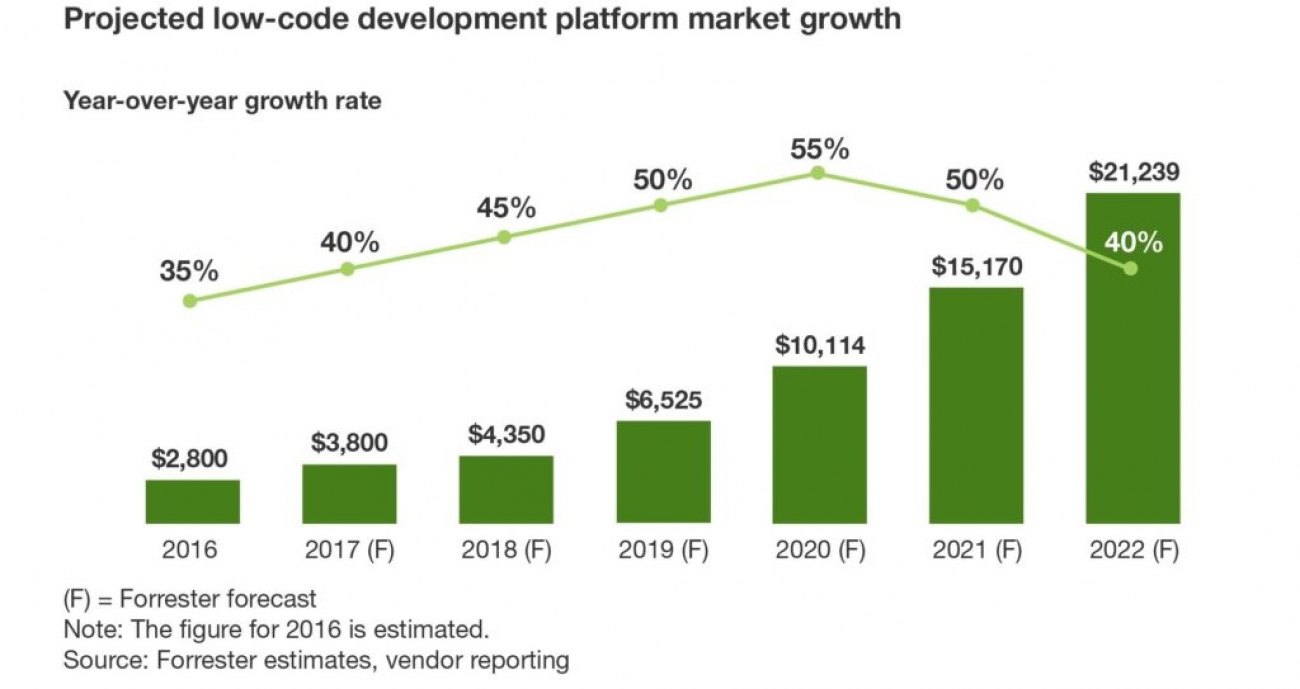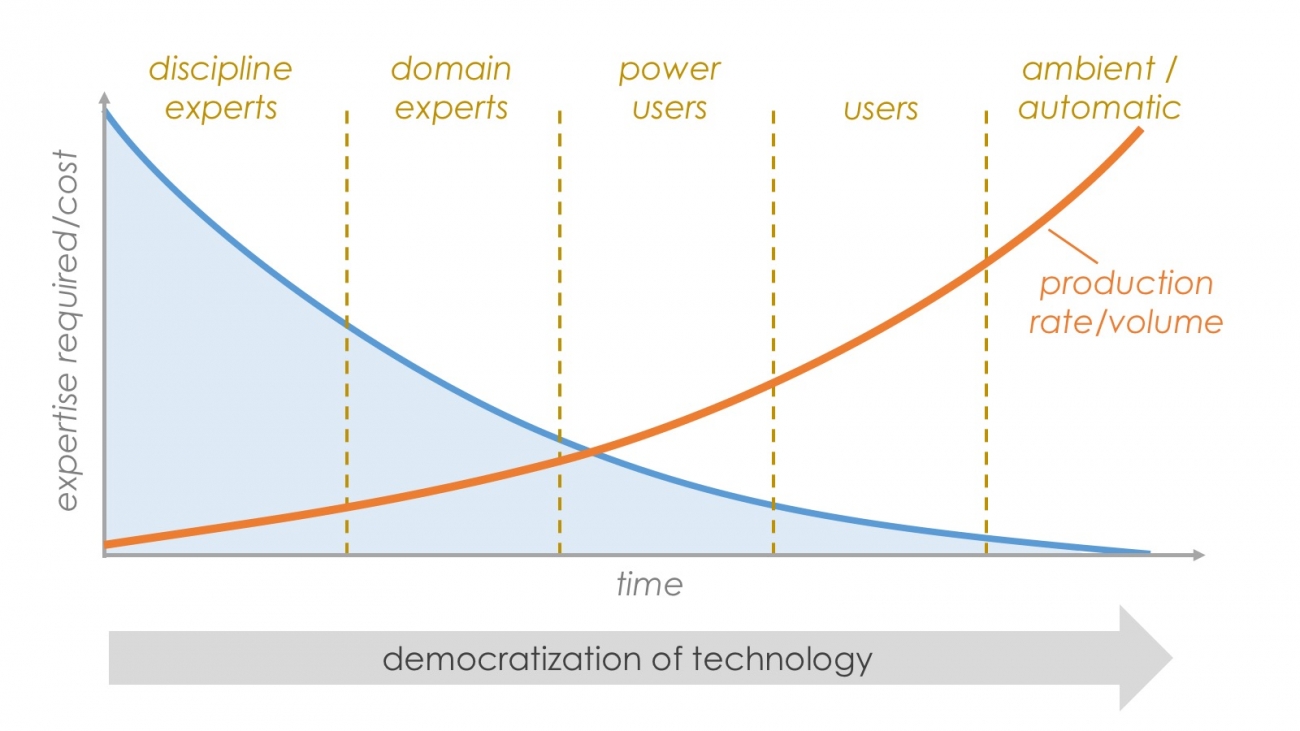Destination low code: Why Low-code platforms offer the enterprise real advantages

By Craig Hanna
22nd Jul 2019
Today enterprises are faced with a wide variety of low code platforms vying for their attention. Yet it was only back in 2014 that the term 'low code' was first used to describe visual template-driven website builders which supplemented or replaced manual coding. Whatever your needs, there's likely a low code tool which meets them.
In this article, we'll examine some of today's platforms and trace the recent evolution of low code and what that means for businesses today.
The capabilities of low code have evolved greatly over the last few years and the market is expanding massively. According to Forrester, the low code market is forecast to grow from $4,350bn in 2018 to $21,239bn by 2022, an almost five-fold increase.

Forrester: Low-code market growth over time
Driving forces behind this predicted growth, include the business need to:
- Speed up development processes in order to meet the challenges of digital transformation
- Alleviate the pressures on time-stretched developers
- Improve collaboration between developers, designers and marketers
- Implement agile marketing methodologies
However, before we delve deeper into these points, it's worth reminding ourselves of what low code is and how it differs from 'no code'.
Low code or no code?
Although the terms low code and no code are often used interchangeably, there is an important difference.
No code platforms: are template-based design systems which allow the user to select pre-built elements (e.g. pages, text boxes, buttons etc) and create websites without writing a single line of code. Users are restricted to the available templates and so are unable code around it.
They are typically used by non-developers AKA 'citizen developers'. A person with no prior coding experience can piece together a website via intuitive visual tools. A typical example would be a start-up company launching its first website via Moonfruit, Wix or one of the many other template driven website builders on the market.
Low code platforms: enable users to utilise templates as above, but also add their own code and – in some cases – create new components which are made available for non-developers. It provides a balance between the simplicity of 'no code' and the flexibility (indeed, extensibility) of manual coding. However, functionality can vary greatly between different platforms offer.
Low code is primarily aimed at professional developers and design teams who want to work in a more productive and collaborative way. For example, Cohesion DX8 allows developers to create bespoke components (or templates) which can be made available to the rest of the design team or even client-side marketers - should they wish to have that power. This ability to seamlessly combine coding with a template-driven approach helps create a 'best of both worlds' experience which unites developer and designer.
A creative revolution in web development
Low code is one stage of an evolution which Martech guru Scott Brinker refers to as 'the democratisation of technology'. This describes how web and app development projects are no longer the sole domain of skilled developers, but instead widened out to a wider community of designers and marketers, as the graph below demonstrates:

ChiefMartech: democratization of technology
(Scott even goes so far as to predict the future beyond no code where AI and automation starts taking hold. But let's not get too far ahead of ourselves!)
Traditionally, developers have been reluctant to embrace low code. It conjures fears of formulaic websites pieced together at rock bottom prices by a throng of drag-and-droppers. But actually, what low code really means for developers is that some processes, such as working on the theming of Drupal 8 websites, can be performed by others, while they can get on with building innovative features which provide the most business value.
In other words: developers can get on with the exciting stuff.
Innovation matters, and so those with the ability to code new features and functionality continue to play a key role in design-and-build projects. The continued high demand for talented developers illustrates how the increasing adoption of low code tools has not sidelined the artisans of web development. Indeed, a 2019 study by CompTIA revealed that software programmers and developers were “far and away the most in-demand job employers sought to fill” in the UK.
Also, the democratisation of technology - as enabled by low code - helps solve a number of key issues for agencies and organisations.
For example, the current shortage of skilled developers is a major bottleneck in many workflows. Many agencies are faced with a growing list of items that need to be actioned, but not enough developers to do them. And even if the talent can be sourced, will budgets stretch that far? In a traditional agency environment, the development team is overwhelmed with mundane processes which could – and arguably should - be shared amongst the wider design team.
So, low code platforms don't represent a threat to developers, but instead an opportunity. Low code means developers remain a vital part of the digital team but instead of being tied up with the everyday, they can create the features which will provide greater value to clients. They are equipped with the power to impress.
This closer team collaboration results in far higher levels or productivity across the digital team which, in turn, transforms agile marketing from business buzzword to business reality.
Low code platforms in action
Here's a selection of some of the key low code platforms in action (including us of course!).
Lowcode website builders
Cohesion DX8: created as tool for agencies and their clients who need to build enterprise-grade websites using Drupal 8 with less developer resource and offer their content authors and marketing teams an enhanced editing experience and richer tool set. Using the DX8 visual UI site builders and designers can create complete Drupal 8 websites with almost no requirements for backend development, in less time and with less resource.
One agency partner, Coherence, has used DX8 to build enterprise-grade websites for Close Brothers (Britain's biggest private bank), Mastek, Royal Mail and City and Guilds. Other agency partners using the platform include Acquia, Cognizant, NDP Studios, Srijan and MeltMedia.
Webflow: chiefly aimed at design and marketing teams building websites or prototypes for a broad range of projects. A visual editor allows designers to accomplish most aspects of web development and there's also the option to add bespoke code. The core user base is mainly small-to-medium sized marketing companies. Webflow has also been used to create prototypes for tech companies like Dell.
Squarespace: predominantly aimed at hobbyists, start-ups and small business professionals. It's a visual website builder in which intuitive tools and ready-made templates allow for the quick build of professional small-scale website designs. While it lacks true extensibility (i.e. combining WYSIWYG with coding is not a seamless experience and new components can't be created for reuse) Squarespace has been used for a diverse range of sites including: personal portfolios, small retailers and even the band Dixie Chicks.
Lowcode app builders
Mendix: aimed at the enterprise app development market. Enables the app building without the need for code – although code can be added if required. Offers high-level integration and the usual rapid development speeds you'd expect from low code. A market leader in the low code app development market, it was bought out by Siemens last year. Zurich Insurance used Mendix in order to build a new app specialising in indemnity insurance.
Outsystems: another leader in the low code app building space. Outsystems is an enterprise-grade app builder with one client reporting a reduction in development hours of 75%. The UK Post Office used Outsystems as part of its digital transformation efforts, succeeding in launching a new travel app which was adopted by more than 300,000 customers within three months of launch.
Appian: finally, Appian is another enterprise-grade solution and a genuine pioneer in the low code space. Combines high level automation capabilities with the usual integration you'd expect. Appian was the low code service of choice for Aegon when they launched a new pensions management app. The app was developed in less than three months.
About the author.

Craig Hanna, Sales and Marketing Director
Craig leads Sales and Marketing at Cohesion and is a regular keynote speaker across Europe and US on a range of topics from marketing to digital transformation. Craig has over 15 years of experience across the digital sector and has worked with DuPont, L'Oreal, KPMG, British Airways and Vodafone among many others.

By Craig Hanna
22nd Jul 2019
Experience
Get a demo and try Acquia Cohesion.
Request a personalized demo and sandbox to test drive Acquia Cohesion for yourself.
Get a demo